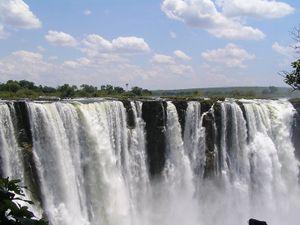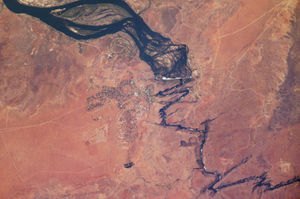Victoria Falls
| Victoria Falls | |
|---|---|
| Mosi-oa-Tunya | |
 Victoria Falls | |
| Location | Livingstone, Zambia Victoria Falls, Zimbabwe |
| Coordinates | 17°55′28″S 25°51′24″E / 17.92444°S 25.85667°ECoordinates: 17°55′28″S 25°51′24″E / 17.92444°S 25.85667°E |
| Type | Waterfall |
| Total height | 355 ft (108 m) (at center) |
| Number of drops | 1 |
| Watercourse | Zambezi River |
| Average flow rate | 1088 m3/s (38,430 cu ft/s) |
| Official name | Mosi-oa-Tunya / Victoria Falls |
| Type | Natural |
| Criteria | vii, viii |
| Designated | 1989 (13th session) |
| Reference no. | 509 |
| State Party | Zambia and Zimbabwe |
| Region | Africa |
Victoria Falls, or Mosi-oa-TunyaTonga: the Smoke that Thunders), is a waterfall in southern Africa on the Zambezi River at the border of Zambia and Zimbabwe.
Naming
David Livingstone, the Scottish missionary and explorer, is believed to have been the first European to view Victoria Falls on 16 November 1855 from what is now known as Livingstone Island, one of two land masses in the middle of the river, immediately upstream from the falls on the Zambian side.[1] Livingstone named his discovery in honour of Queen Victoria of Britain, but the indigenous name, Mosi-oa-Tunya—"the smoke that thunders"—continues in common usage as well. The nearby national park in Zambia is named Mosi-oa-Tunya,[2] whereas the national park and town on the Zimbabwean shore are both named Victoria Falls.[3][4] The World Heritage List officially recognizes both names.[5]
In 2013, the government of Zimbabwe declared its intention to officially rename the falls "Mosi-oa-Tunya", citing continuity with other renamings such as Harare (from Salisbury), and Zimbabwe (from Rhodesia).[6]
Size
While it is neither the highest nor the widest waterfall in the world, it is classified as the largest, based on its combined width of 1,708 metres (5,604 ft)[7] and height of 108 metres (354 ft),[8] resulting in the world's largest sheet of falling water. Victoria Falls is roughly twice the height of North America's Niagara Falls and well over twice the width of its Horseshoe Falls. In height and width Victoria Falls is rivalled only by Argentina and Brazil's Iguazu Falls. See table for comparisons.[5]
For a considerable distance upstream from the falls the Zambezi flows over a level sheet of basalt, in a shallow valley, bounded by low and distant sandstone hills. The river's course is dotted with numerous tree-covered islands, which increase in number as the river approaches the falls. There are no mountains, escarpments, or deep valleys; only a flat plateau extending hundreds of kilometres in all directions.
The falls are formed as the full width of the river plummets in a single vertical drop into a transverse chasm 1708 metres (5604 ft) wide, carved by its waters along a fracture zone in the basalt plateau. The depth of the chasm, called the First Gorge, varies from 80 metres (260 ft) at its western end to 108 metres (354 ft) in the centre. The only outlet to the First Gorge is a 110 metres (360 ft) wide gap about two-thirds of the way across the width of the falls from the western end, through which the whole volume of the river pours into the Victoria Falls gorges.
There are two islands on the crest of the falls that are large enough to divide the curtain of water even at full flood: Boaruka Island (or Cataract Island) near the western bank, and Livingstone Island near the middle—the point from which Livingstone first viewed the falls. At less than full flood, additional islets divide the curtain of water into separate parallel streams. The main streams are named, in order from Zimbabwe (west) to Zambia (east): Devil's Cataract (called Leaping Water by some), Main Falls, Rainbow Falls (the highest) and the Eastern Cataract.
The Zambezi river, upstream from the falls, experiences a rainy season from late November to early April, and a dry season the rest of the year. The river's annual flood season is February to May with a peak in April,[9] The spray from the falls typically rises to a height of over 400 metres (1,300 ft), and sometimes even twice as high, and is visible from up to 48 km (30 mi) away. At full moon, a "moonbow" can be seen in the spray instead of the usual daylight rainbow. During the flood season, however, it is impossible to see the foot of the falls and most of its face, and the walks along the cliff opposite it are in a constant shower and shrouded in mist. Close to the edge of the cliff, spray shoots upward like inverted rain, especially at Zambia's Knife-Edge Bridge.[10]
As the dry season takes effect, the islets on the crest become wider and more numerous, and in September to January up to half of the rocky face of the falls may become dry and the bottom of the First Gorge can be seen along most of its length. At this time it becomes possible (though not necessarily safe) to walk across some stretches of the river at the crest. It is also possible to walk to the bottom of the First Gorge at the Zimbabwean side. The minimum flow, which occurs in November, is around a tenth of the April figure; this variation in flow is greater than that of other major falls, and causes Victoria Falls' annual average flow rate to be lower than might be expected based on the maximum flow.[10]
Formation
The recent geological history of Victoria Falls can be seen in the form of the gorges below the falls. The basalt plateau over which the Upper Zambezi flows has many large cracks filled with weaker sandstone. In the area of the current falls the largest cracks run roughly east to west (some run nearly north-east to south-west), with smaller north-south cracks connecting them.
Over at least 100,000 years, the falls have been receding upstream through the Batoka Gorges, eroding the sandstone-filled cracks to form the gorges. The river's course in the current vicinity of the falls is north to south, so it opens up the large east-west cracks across its full width, then it cuts back through a short north-south crack to the next east-west one. The river has fallen in different eras into different chasms which now form a series of sharply zig-zagging gorges downstream from the falls.[10]
Apart from some dry sections, the Second to Fifth and the Songwe Gorges each represents a past site of the falls at a time when they fell into one long straight chasm as they do now.[10] Their sizes indicate that we are not living in the age of the widest-ever falls.
The falls have already started cutting back the next major gorge, at the dip in one side of the "Devil's Cataract" (also known as "Leaping Waters") section of the falls. This is not actually a north-south crack, but a large east-northeast line of weakness across the river, where the next full-width falls will eventually form.
Further geological history of the course of the Zambezi River is in the article of that name.
- ↑ Lua error in ...ribunto/includes/engines/LuaCommon/lualib/mwInit.lua at line 23: bad argument #1 to 'old_ipairs' (table expected, got nil).
- ↑ National Parks and Nature Reserves of Zambia, World Institute for Conservation and Environment.
- ↑ National Parks and Nature Reserves of Zimbabwe, World Institute for Conservation and Environment.
- ↑ Lua error in ...ribunto/includes/engines/LuaCommon/lualib/mwInit.lua at line 23: bad argument #1 to 'old_ipairs' (table expected, got nil).
- ↑ 5.0 5.1 World Waterfalls Website accessed 1 March 2007
- ↑ Lua error in ...ribunto/includes/engines/LuaCommon/lualib/mwInit.lua at line 23: bad argument #1 to 'old_ipairs' (table expected, got nil).
- ↑ Southern Africa Places (2009). Victoria Falls. Retrieved on 2009-05-18 from Victoria Falls - South Africa Places
- ↑ Lua error in ...ribunto/includes/engines/LuaCommon/lualib/mwInit.lua at line 23: bad argument #1 to 'old_ipairs' (table expected, got nil).
- ↑ World Commission on Dams website: "Case Study — Kariba Dam-Zambezi River Basin" Annex 13 & 14 Victoria Falls Mean Monthly Flows. Website accessed 1 March 2007. This website gives mean monthly flow rates in cubic metres per second (i.e., the total volume of water passing in each calendar month divided by the number of seconds in the month), the standard measure used in hydrology to indicate seasonal variation in flow. A figure of around 9,000 m3/s (318,000 cu ft) is quoted by many websites for Victoria Falls but this is the mean maximum instantaneous rate, which is only achieved for a little amount of days per year. The figure of 536 million m3/minute (18.9 billion cu ft/min) on some websites (e.g. ZNTB) is an error for 536 million litres/minute (equivalent to 9100 m3/s or 142 million U.S. gallons/min). The '10-year maximum' is the mean of the maximum monthly rate returned in a ten-year period.
- ↑ 10.0 10.1 10.2 10.3 Lua error in ...ribunto/includes/engines/LuaCommon/lualib/mwInit.lua at line 23: bad argument #1 to 'old_ipairs' (table expected, got nil).
